Class trip: Edwards Garden (Leslie and Lawrence) on April 25th. If you would like to volunteer, please let me know.
Trip Review
Our trip to Edwards Gardens was very successful. The children learned many things about gardens. We got to see how worms live, what they eat, how they make soil and even got to hold them. We were able to plant carrots and parsnips. We learned what a plant needs to grow (water, sun, soil and wind) and we searched for signs of spring in the garden (looking for the sun, finding buds on the trees, find new plants sprouting up from the garden, looking for bugs in the garden). I encourage you to take your children to Edward Gardens. They can check on their vegetables and see the growth progress. Our vegetables that we planted will be harvested and given to the homeless. It is part of the Garden's charity program!
SPRING ACTIVITIES
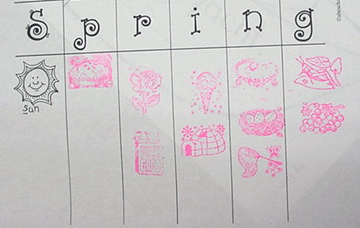
1. The children have to find stamps with pictures beginning with the sounds of the letters in the word SPRING and stamp them below the letters.
Here is an example of one our students finding the right stamp to go in the box
Here is an example of one our students finding the right stamp to go in the box
2. We will be keeping track of the weather every day for a month on our Weather Watcher's Report. We will be going outside to check the weather and checking the computer for the temperature.
Predictable Chart
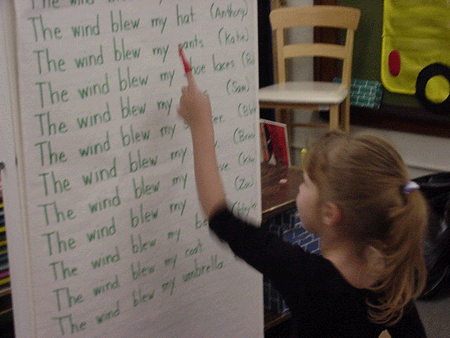
3 Our predictable chart sentence began with, "The wind blew..." We will
read it daily.
| |
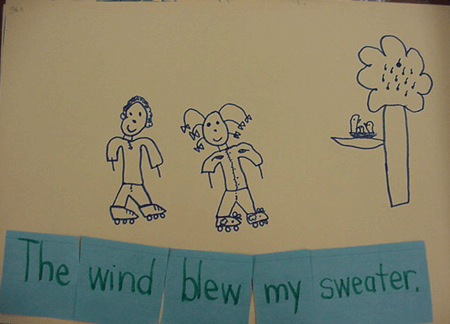
4. For a center, I will write each child's sentence on a strip and cut it apart. They will have
to put it back together in order, glue it to the paper and draw a picture.
Journal Topics:
*What do plants need to grow?
*What kind of garden would you like to tend?
*Draw a plant and label its parts.
Books
How a Seed Grows by Helene J. Jordan
The Carrot Seed by Ruth Krauss
From Seed To Plant by Gail Gibbons
A Seed Grows by Pamela Hickman
One Bean by Anne Rockwell
Eating the Alphabet by Lois Ehlert
Growing Vegetable Soup by Lois Ehlert
The Tiny Seed by Eric Carle
Planting a Rainbow by Lois Ehlert
*After reading one or all of these books, we brainstorm and list all the
plants we can think of, sorting them into edible plants and non-edible
plants. Students will complete their own Plants! booklet: page 1- A (carrot) is a plant. It is (edible). We can (eat) it.
page 2- A (banana) is a plant. It is (edible). We can (eat) it.
page 3- A (potato) is a plant. It is (edible). We can (eat) it.
page 4- A (tree) is a plant. It is (non-edible). We can (climb) it.Students will fill in the blanks and illustrate each page using their own
drawings, magazine pictures, or clip art.
Jack's Garden by Henry Cole
Flower Garden by Eve Bunting
The Reason For a Flower by Ruth Heller
*After reading any of these books, we discuss all sorts of "parts"
(parts of a car, parts of our bodies, parts of a tree, parts of a chair,
etc.). Using the overhead projector or the chalkboard, we draw an
object and label each of its "parts." We usually draw/discuss at least
2 different objects before turning the discussion to parts of a flower.
Each student draws a flower clearly depicting the stem, petals, leaves,
roots, etc. On the backside, student choose another object (chair, body, apple, jet, etc.) to draw and label each of its parts. This can be extended by finding objects around the school (or homework project) which are made up of parts. Disassemble the
objects and "misplace" a few of the parts. Allow them to reassemble the objects. Discuss an object's usefulness without all its parts. The same applies to plants. Students return to their pictures to write about each part's use to the object:
The leg is important because it holds up the table .
The leaf is important because it makes chlorophyll
Heathly Eating
1.Begin the unit by filling in a KWL chart. Ask the students what they Know about food and what they Wonder about food. At the conclusion, fill in the "What I Learned" section.
2. Taste test and then graph students' favorite milk flavor (White or Chocolate Milk)
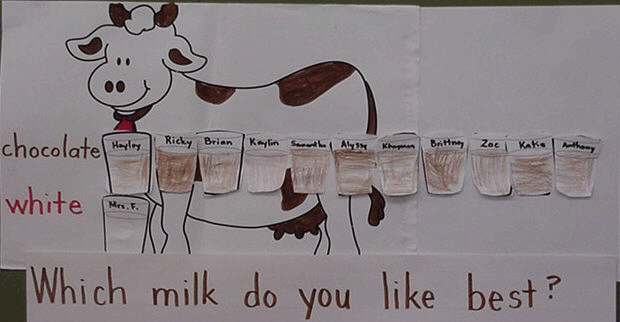
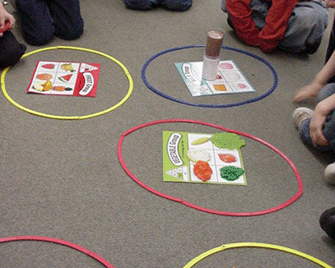
3.Sort play foods or food pictures into rings or hula hoops to categoize them by the groups on the Food Pyramid.(Fruits/Vegetables...Dairy....Bread/Grains....Meat...Alternatives (junk food). After, take a survey and graph what is everyone's favourite food in each section.
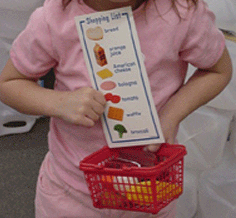
4. Make shopping list. What would you want to buy at the grocery store? They can use words or cut out pictures from flyers and make a collage.
5. Cut out food pictures from the Grocery store flyers and sort them into categories (Fruit, Vegetables, Meat, Dairy and Junk Food)
5. Cut out food pictures from the Grocery store flyers and sort them into categories (Fruit, Vegetables, Meat, Dairy and Junk Food)
Math : Addition and Subtraction
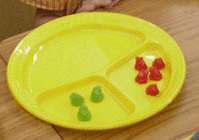
1. A plate divided into three sections can be used to illustrate both addition and subtraction. For addition, put manipulatives in both small sections (5+3). Move all of them down to the larger bottom section to show the sum. For subtraction, begin with all of the manipulatives in the large section and then remove some to the smaller section to find out how many are left.
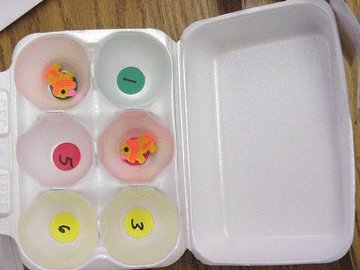
2. Place stickers with numbers in the bottome of an egg carton. Place 2 small erasers in the carton and shake it up. Open and write and addition problem about the two numbers where the erasers fell. For example, the eraser fell on 2 and 4 (2+4=6.)
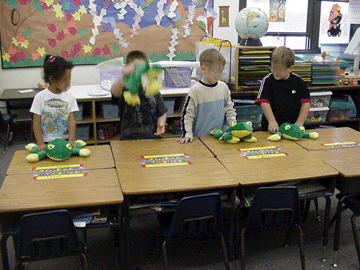
3. Sing songs or read books to act out subtraction problems. The children above were acting out Five Green and Speckled Frogs, taking away one frog during each verse. Other songs: 5 little monkeys jumping on the bed, 10 in the bed, 5 little ducks.
4.Grab-Bag Mat
Letters this month
Ss
S P R I N G
S P R I N G
S P R I N G
That spells SPRING!!
S P R I N G
S P R I N G
S P R I N G
We love SPRING!!!
Tt
Tip toe through the tulips.
Tip toe through the tulips.
Tip toe through the tulips.
t-t-t-t-t
Uu
Mrs Uppal's name starts with a Uu.
Mrs Uppal's name starts with a Uu.
It's not a p, it's not s, it's not an o, it's not a r.
Mrs Uppal's name starts with a Uu
u-u-u
Vv
Go for a ride on the starfall van.
Go for a ride on the starfall van.
vvv van
vvv van
Ww
Worms, worms, wiggly worms
w-w-w
Xx
Can you name a word that starts with Xx?
Xylophone, x-ray are just two
Words that end in Xx are easy to do.
Box and Fox.
x-x-x
Give each partner group a lunch bag with 10-12 unifix cubes or magnetic numbers in two colors (5-6 of each color). Have each child reach in and grab a handful of cubes, pull them out, sort and count each color. Have them write the number sentence. For instance if someone pulled out 4 red and 4 blue cubes, they would write 4 + 4 = 8. Then the next child takes his turn. I find it is helpful for children to write everyone's equation as it gives them something to do while waiting for their turn. You can do this as a small group activity as well.
5. Cards
Give each person a few cards each. Each person flips over one card at a time. Then they have to make a number story. For example, child A flips a 2 and child B flips a 4. The number story would be 2 + 4 = 6
6. Use dominoes turned horizontally and have students record the number sentence according to the dots on the domino. 3 dots + 2 dots = 5 dots
Letters this month
Ss
S P R I N G
S P R I N G
S P R I N G
That spells SPRING!!
S P R I N G
S P R I N G
S P R I N G
We love SPRING!!!
Tt
Tip toe through the tulips.
Tip toe through the tulips.
Tip toe through the tulips.
t-t-t-t-t
Uu
Mrs Uppal's name starts with a Uu.
Mrs Uppal's name starts with a Uu.
It's not a p, it's not s, it's not an o, it's not a r.
Mrs Uppal's name starts with a Uu
u-u-u
Vv
Go for a ride on the starfall van.
Go for a ride on the starfall van.
vvv van
vvv van
Ww
Worms, worms, wiggly worms
w-w-w
Xx
Can you name a word that starts with Xx?
Xylophone, x-ray are just two
Words that end in Xx are easy to do.
Box and Fox.
x-x-x
Yy
Yo, yes.
Yo, yes.
Yo, yes.
y-y-y Yo
y-y-y Yo
Zz
z-z-z zipper
z-z-z zebra
z-z-z zzzzzzzzzzzzz.
Goodnight!!

Happy Spring! :)
ReplyDeleteHello Ms.McKenzie! How are you doing?
ReplyDeleteThis month looks like the one filled with lot of activity.
Cant wait to see how Mayez is going to react and learn things.
Wanted to ask you will they be learning any numbers also? And what will be the sight words for this week or month.
Kindly let me know as I can help my kid brush up with it.
Thank you!
Hi, below is the dolch word list which is a recommended word list that kindergartens should know how to recognize and spell by grade one. We use these words everyday in the morning message, they are posted around the room and we use them in our writing. The children are always exposed to numbers. We count the amount of kids in the class everyday, the numbers from 1-100 are displayed in the class. We read numeracy stories every week.
ReplyDeleteDolch Word List
These are common words that children should learn how to read and write. From 50-75% of all words used in school books, library books, newspapers, and magazines are in the Dolch Basic Sight Vocabulary of 220 words (preschool thru Grade 3). The Dolch word list is made up of "service words" (pronouns, adjectives, adverbs, prepositions, conjunctions, and verbs)
http://www.kidzone.ws/dolch/kindergarten.htm
That was helpful Mrs. Mckenzie.
ReplyDeleteThank you! :)
Hello Mrs. McKenzie!
ReplyDeleteHow are you doing?
Can you please give us a copy of April calender?We dont have one.
I also wanted to know how Mayez is doing at school.
Kindly let me know when can we talk over the phone about him.
Thank you.